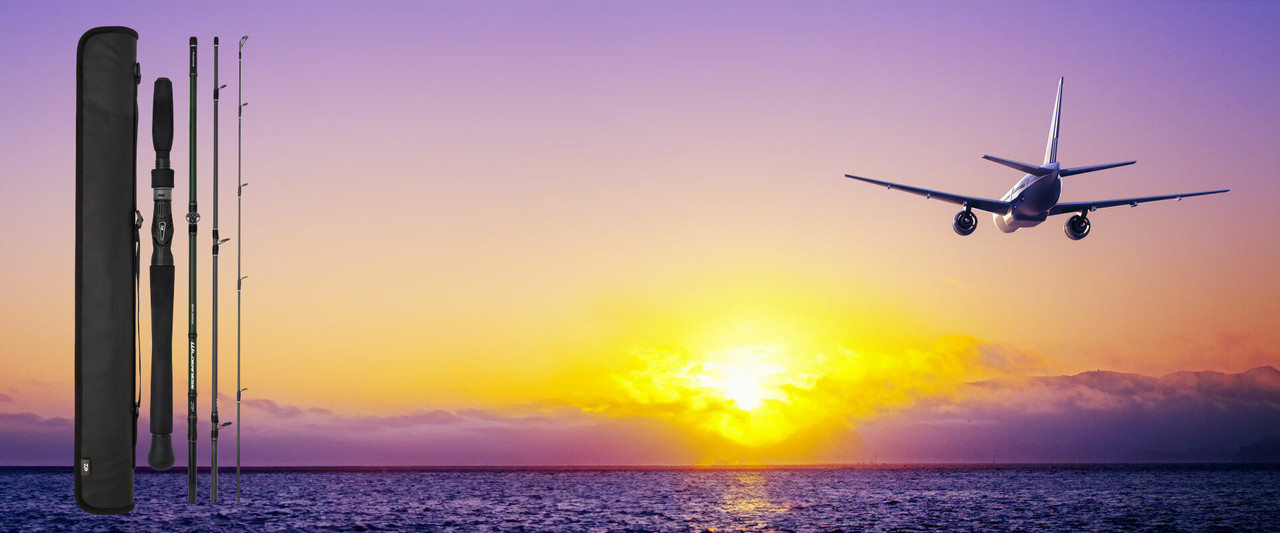An Angler's Guide to Travel Fishing Rods
In the past, choosing a travel rod often felt like a compromise, trading performance for portability. Thankfully, those days are long gone. Modern multi-piece rods from the world's best brands deliver the crisp, sensitive action you'd expect from a single-piece rod, but in a package you can take anywhere. This guide will walk you through what to look for.
A Note From Our Local Experts
"One of the biggest questions we get in the shop is, 'Are these multi-piece rods actually strong enough?' The answer is a definite yes. The technology is incredible these days, and the ferrules (joins) are designed to be extremely reliable. I hear stories all the time in my store from customers who keep a rod in the car for an impromptu lunch-break session at lake Illawarra, or those who are upgrading their light estuary travel rod for a heavier model to take on a barra trip up north for the run off. The feedback is generally consistent: a good travel rod delivers better actions and reslults.
The real benefit is simple: the more you have a rod with you ready to go, the more you may desire to go fishing. A good travel rod at the get-go can make that happen."
- Ben Czulowski, Owner, Fishing Tackle Shop
How to Choose the Right Travel Rod
The best travel rod is the one that matches the fish you want to catch. Here’s a breakdown based on common Australian fishing scenarios:
- For Estuary & Freshwater Finesse (Bream, Flathead, Trout, Bass): This is the most popular category. Look for a 3-5 piece spinning rod, typically 6'6" to 7'2" long, with a line rating of 1-4kg or 2-5kg. This setup is light, sensitive, and perfect for casting small lures and baits.
- For Heavier Inshore & Barra (Snapper, Mulloway, Barramundi): If you're targeting bigger, tougher fish, you'll need more power. A 3-5+ piece rod in the 4-8kg or 5-10kg class is ideal. These rods still pack down small for travel but have the backbone needed to handle larger lures and stronger fish.
- For Beach & Rock Fishing (Salmon, Tailor): For this style, you need casting distance. Look for a longer 3-4 piece rod, typically 9-12ft in length with a line rating of 5kg+. These will allow you to cast metal lures or baits past the shore break while still fitting into your car easily.
A Word on Our Top Brands
While we stock a wide range, our most popular travel rods come from two key brands, each with its own strengths:
- Shimano Travel Rods: Shimano's travel rods often focus on high-performance graphite and premium components to achieve a crisp, sensitive feel. They frequently use components like Fuji guides and custom reel seats, which are typically found on high-end one-piece rods. This focus on premium hardware ensures that the rod's performance, from casting feel to bite detection, is not compromised by its multi-piece design.
- Daiwa Travel Rods: Daiwa is known for offering a fantastic balance of innovative technology and great value. They often incorporate their proprietary technologies, like the V-Joint system, into their travel rods. This technology allows the ferrules to flex with the rod, creating a more seamless, parabolic curve under load and eliminating the "flat spots" that were common in older multi-piece designs.
Pro-Tips for Using Your Travel Rod
- Keep Your Ferrules Clean: Sand and dirt are the enemies of a multi-piece rod. Before assembling, quickly wipe both ends of the ferrules to ensure a clean, snug fit. This prevents jamming and excessive wear.
- Check Your Ferrules While Fishing: After every dozen or so casts, give the sections a gentle twist to ensure they are still fitted together firmly. This prevents sections from flying off during a cast.
- Build a Dedicated Travel Kit: The key to making your travel rod effective is having a minimalist tackle kit ready to go with it. For a versatile estuary setup that covers most light tackle fishing situations, a small, waterproof tackle tray should contain: a few 2.5-3 inch soft plastics in natural and bright colours, a couple of 70-90mm hardbody lures, a small selection of jigheads (1/8oz, 1/6oz), and a spool of 10lb fluorocarbon leader. This simple kit, kept with your rod, covers 90% of impromptu fishing opportunities.
Frequently Asked Questions
Are modern travel rods as good as one-piece rods?
The performance gap has closed dramatically due to huge advancements in rod technology. Modern travel rods use high-modulus, multi-directional carbon blanks that are lighter and more sensitive than ever before. More importantly, the ferrules (joins) are now precision-engineered to transfer power and vibration seamlessly through the blank. This eliminates the stiff "flat spots" and weak points of older designs, resulting in a rod with an action and sensitivity that is virtually indistinguishable from a one-piece for most fishing situations.
What is the benefit of a 3-5 piece travel rod over a standard 2-piece rod?
The main benefit is a significantly shorter packed length. A standard 2-piece rod is often still over a metre long when broken down, making it difficult to pack in a suitcase or a hiking bag. A 3-5 piece rod, however, packs down into a much more compact tube that can easily fit inside luggage, a backpack, or under a car seat, making it a far superior choice for genuine travel.
Are telescopic fishing rods a good choice?
Telescopic rods offer unmatched convenience and are fantastic for spontaneous fishing or keeping in the car. However, due to their many sliding joints, their casting performance and sensitivity are generally not as refined as a quality multi-piece rod.
Can I take a travel rod on a plane as carry-on luggage?
It depends on the airline. While many shorter models in their tubes may be allowed, it is not guaranteed. The safest approach is to pack your travel rod tube within your main checked luggage to avoid any issues at airport security.



